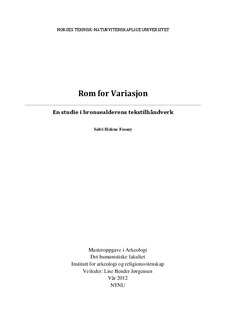| dc.contributor.advisor | Jørgensen, Lise Bender | nb_NO |
| dc.contributor.author | Fossøy, Sølvi Helene | nb_NO |
| dc.date.accessioned | 2014-12-19T13:04:26Z | |
| dc.date.available | 2014-12-19T13:04:26Z | |
| dc.date.created | 2012-09-05 | nb_NO |
| dc.date.issued | 2012 | nb_NO |
| dc.identifier | 549661 | nb_NO |
| dc.identifier.uri | http://hdl.handle.net/11250/242905 | |
| dc.description.abstract | An unusually large amount of Bronze Age textiles have been preserved in southern Scandinavia. My research on the Bronze Age textiles has focused on yarn diameter and twist angles, sources of variation in an apparent uniform material. Differences in the textiles are due to varying quality of raw materials and the usage of different types of tools, but also the skill of the craftsperson and how the handcraft knowledge is transmitted to new generations. The room for variation and creativity in the handcraft seems to be closely linked to the education strategy.
The South Scandinavian textile material can be separated in two different groups. The specialized textiles show high technical variation, produced to fulfill specific tasks as belts, corded skirts or hair nets. The generalized textiles, tabby woven and visually uniform, are used in all the known woven Bronze Age clothing. The yarns of the specialized textiles have shown to be more even than the coarse yarn of the generalized textiles. The knowledge of generalized textiles has probably been taught in a cultural conservative way, giving the textiles a very uniform appearance and little room for variation. The specialized textiles had more room for innovation and variation, and were probably made by more specialized crafts people taking their higher complexity. Several changes in the textile handcraft took place between PII and PIII. The generalized textiles show less uniformity and change from s/ztextiles to s/s-textiles. This change might be linked to an alteration of ideological beliefs concerning the spin direction.
A high amount of generalized textiles are found in oak-coffin graves. In order to produce this amount of textiles one must have had access to a big amount of resources and enough skilled craftspeople. Both the spinning of the wool and the weaving was a job for several people. The specialized textiles are not so numerous and required less resources. Only one craftsperson was needed to make the yarn and do the weaving of for example a belt. Due to the dissimilar nature of the textile groups they can be linked to two different kinds of style. The uniform generalized textiles could have been used as emblemic style, communicating a common South Scandinavian Bronze Age Identity. The specialized textiles, however, have a variation that can be used for assertive style, communicating personal identity. Especially female graves have show to contain a high number of very different kinds of specialized textiles. | nb_NO |
| dc.language | nor | nb_NO |
| dc.publisher | Norges teknisk-naturvitenskapelige universitet, Det humanistiske fakultet, Institutt for arkeologi og religionsvitenskap | nb_NO |
| dc.subject | Humanities, Theology | en_GB |
| dc.subject | Tekstil | no_NO |
| dc.subject | opplæring | no_NO |
| dc.subject | drakter | no_NO |
| dc.subject | veving | no_NO |
| dc.title | Rom for variasjon: En studie i bronsealderens tekstilhåndverk | nb_NO |
| dc.type | Master thesis | nb_NO |
| dc.contributor.department | Norges teknisk-naturvitenskapelige universitet, Det humanistiske fakultet, Institutt for arkeologi og religionsvitenskap | nb_NO |
